Application of OsDGD2beta gene in cultivating male sterile rice varieties
A technology of male sterility and β gene, applied in application, genetic engineering, plant gene improvement, etc., can solve the problems of unclear function and less research on OsDGD2β gene
- Summary
- Abstract
- Description
- Claims
- Application Information
AI Technical Summary
Problems solved by technology
Method used
Image
Examples
Embodiment 1
[0034] Construction and identification of embodiment 1 mutant
[0035] 1. Construction of mutants
[0036] A genome editing vector targeting the OsDGD2β mutation was constructed using the CRISPR vector pHUN4c12, and a specific target sequence (genome specific sg RNA sequence: AGGTCAATAGTTTGCAATG) targeting the third exon of OsDGD2β was designed by CRISPR-P 1.0, and the oligonucleotide chain ( D2b-T / -B) (D2b-T: GGCACATTGCAAACTATTGACCT, D2b-B: AAACAGGTCAATAGTTTGCAATG); the oligonucleotide strands were combined with annealing buffer, the pHUN4c12 vector was digested with BsaI-HF (NEB), and T4 ligase was used Ligated to oligonucleotide duplex. The connected vector, named pHUN4c12s:OsDGD2β, was transformed into DH5α E. coli competent, and the inserted sgRNA was verified by sequencing primer (seq-F): GCCCATTACGCAATTGGACG.
[0037] The recombinant vector was transferred to Agrobacterium (EHA105), and further transferred to the mature seed callus of the japonica rice variety Xidao N...
Embodiment 2
[0041] Phenotypic characteristics of embodiment 2 mutants
[0042] 1. Research on anther structure and pollen fertility
[0043] at T 0 On the day of earing of generation mutant osdgd2β and wild type, the spikelets were collected in centrifuge tubes with fixative FAA (formalin / acetic acid / alcohol) and stored at room temperature. The flower and anther structure of mutant osdgd2β and wild type were observed under ordinary microscope, and the pollen fertility of 1% IKI staining was observed under compound microscope.
[0044] Such as figure 2 As shown, during anthesis, the mutant leaf sheath panicles were not fully exposed compared with the wild type. Moreover, compared with the wild type at flowering, the anthers of most spikelets in the mutant were not exposed ( figure 2 B). In addition, in order to evaluate whether the mutant affects pistil fertility, the mutant was detasseled and then crossed with the wild type as the male parent. The results showed that these hybrid ...
Embodiment 3
[0050] Example 3 Gene Expression Analysis
[0051] The leaves and anthers of mutant osdgd2β and wild type were collected on the day of flowering, total RNA was extracted with RNA extraction kit, RNA was reverse transcribed using reverse transcription kit, and Hieff TM qPCR The reaction mixture was subjected to qRT-PCR assay.
[0052] The experiment was carried out three biological repetitions and three technical repetitions, OsActin was used as an internal reference, and passed 2 -ΔΔCt The analysis method calculates the relative expression level of the gene, and the primers are shown in Table 1.
[0053] Table 1 Primer Sequence
[0054]
[0055] Such as Figure 5 As shown, the OsDGD2β in the leaves and anthers of the mutants were significantly reduced, respectively by about 65.26% and 88.62%, and the other DGDG synthesis genes in the leaves were not significantly different from those of the wild type ( Figure 5 A), and in the anthers, except for OsDGD2α, there were ...
PUM
 Login to View More
Login to View More Abstract
Description
Claims
Application Information
 Login to View More
Login to View More - R&D
- Intellectual Property
- Life Sciences
- Materials
- Tech Scout
- Unparalleled Data Quality
- Higher Quality Content
- 60% Fewer Hallucinations
Browse by: Latest US Patents, China's latest patents, Technical Efficacy Thesaurus, Application Domain, Technology Topic, Popular Technical Reports.
© 2025 PatSnap. All rights reserved.Legal|Privacy policy|Modern Slavery Act Transparency Statement|Sitemap|About US| Contact US: help@patsnap.com



